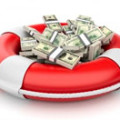Do the fluctuations in stock market scare you in your dreams?
Are you clinging upon some stocks to save you in financial crisis?
Do you have an Emergency Fund in your savings account?
If not, then don’t bite your nails it’s not too late to boost up your savings! We provide you a quick guide with some interesting tips on how to establish an Emergency savings fund. An Emergency fund is an essential part of your savings plan which can reduce your stress in times of financial crisis. It may seem unimportant in the beginning but can pay off at the right time.
This emergency fund can play a very big role when there is a sudden urge for money for your car, home repair or even in the worst crisis of unemployment or illness. Having an emergency fund solves majority of the financial problems and you will always be prepared to sail by the storm.
But how will you know how much you need? Let’s figure out some permutation and combination to have a flair idea of how much to begin with.
How much to save?
The first thing that strikes in our mind is how much to save and where to begin with. A time target would give clarity on how much to save. It is important to understand that your emergency fund should be able to help you survive for at least 6 to 9 months but it will take years to get to this stage and might feel like a burden initially. This emergency fund should be enough to cover your major expenses. But this might seem like a huge amount to begin with.
So, the ideal step should be to have a low initial target so that it doesn’t strangle you to reach the target. You are free to start with a three-month plan as a beginner.
The Three-month plan:
The most important step is to have a plan that gives you clarity on how to organize your three-month plan. Saving money on a monthly-basis would feel like a difficult goal instead a plan to save a small amount on a weekly basis. Start by categorizing by stuffs on which you saved the money like cutting off the regular expenses you do on a restaurant or reduce the number of times you use a taxi and see how much you can save on a weekly basis on each category.
For instance:
| Category | Week | Amount |
| Restaurant | 1 | 25 |
| Taxi | 2 | 20 |
You can create a similar tracker on Google Sheets or MS Excel to get a detailed report on how much you save every week and where you can save more. This way you can analyse how much you saved at the end of three-months.
The Target Amount:
Before you start your savings plan, it is important to have a target amount set. Decide on the priorities to start with your emergency savings plan. Here are the few categories to consider before deciding the target amount:
- House Expenses: One of the most important things to consider for your emergency savings fund is the amount to cover your housing expenses. The housing expense can be the rent or the mortgage, insurance, maintenance, property taxes and utilities. The target amount should cover your housing expenses.
- Dine In & Dine Out Expenses: Keep track of your monthly food expenses to add in the target amount. Every penny you spend on your coffee to the candle light dinner sums up to this target amount. So, set the target carefully for this category and try reducing the expenses wherever possible.
- Insurance Amount: In times of crisis, this insurance amount plays a vital role to recover the incurred losses. Your target amount should consider the insurance expenses for sure.
- Vehicle Expenses: If you own a car or a motor cycle, then your target amount should cover the expenses such as loan, maintenance cost, fuel, emergency repair and insurance.
Where to save?
Now that you have a plan with a target amount, it is important to know where to save your money to get the best possible benefits. Begin with targeting the holiday bonus or tax refunds to put in your emergency savings fund. The best way is to set an automatic transfer of this money to your savings account. You are free to decide on where to put this money.
The two options:
- Regular Savings Account:
- Easy access to money anywhere anytime
- Less interest rates
- Suitable for beginners
- Money Market Account:
- Higher interest rates with easy maintenance
- Higher returns
- Requires a high amount as minimum balance
Bottom line
No matter where you opt to put your money, it is important to access your emergency fund in time of crisis and to be prepared to face the unexpected. Hope this blog helped you to plan on your emergency funds.
Jennifer Cooper is a personal finance blogger who write at pro finance tips covering everything about debt management, frugal living, credit cards and money saving tips. When she is not writing, you can find her working on her home renovation projects.








